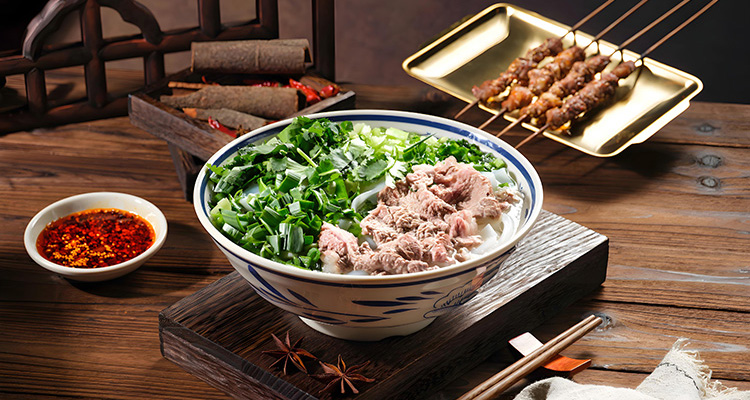Huainan Beef Soup: Classic Anhui Breakfast Soup
1. From Qing‑Era Docks to Nationwide Favorite: The Soup’s Century‑Long Journey
Huainan beef soup originated in Huainan, Anhui Province, during the Qing dynasty. The city thrived with Huai River transport, and dockworkers needed an affordable, energy-rich meal. Local yellow cattle meat and beef bones were slowly simmered into a nourishing broth. Praised for its rich flavor and tender meat, the soup became a staple for laborers and gradually evolved into a representative Anhui snack. Today, it’s found across China, moving from a simple workers’ meal to a beloved national breakfast thanks to its time-tested taste.
2. Clear Broth, Tender Meat, Full Flavor: The Standards of a Good Bowl
A genuine Huainan beef soup looks simple but follows strict quality standards. Ingredients include local yellow cattle beef and beef bones. The meat is fine-textured with balanced fat, while crushed bones release marrow into the stock. Preparation is key: start with cold water, bring to a boil over high heat, then simmer gently for hours, skimming foam to keep the broth clear rather than cloudy or greasy. The result is a clear yet deeply flavored broth—fragrant without off-notes—perfectly embodying the essence of umami.
3. More Than Broth: A Symphony of Textures and Tastes
If the broth is the soul, the toppings are the melody. A proper bowl includes thinly sliced, melt-in-your-mouth beef; soft vermicelli soaked in flavorful stock; thin tofu skin (qianzhang) adding bean aroma and chew; and a scattering of fresh cilantro and green garlic shoots to brighten the bowl. Some shops add crunchy bean sprouts or soft potato noodles for extra texture. Locals often tear crisp sesame flatbread or youtiao (fried dough sticks) into pieces and soak them in the soup—resulting in a satisfyingly soft, slightly chewy bite that harmonizes with broth, meat, and greens.
4. How to Taste Huainan Beef Soup Like a Local
First-time visitors can elevate their experience by following local customs. Start by sipping the plain broth to appreciate its pure, savory depth. Then season to taste with common condiments—chili oil, fragrant black vinegar, and minced garlic. Huainan’s chili oil is aromatic without harsh heat and enhances the soup without overpowering. Dip flatbread or youtiao into the bowl and let it absorb the broth before eating. Always eat while the soup is hot to capture the fullest aroma and comforting warmth.
5. Traveler’s Practical Guide: Where to Eat and How to Order
Beef soup stalls and small shops are ubiquitous in Huainan, typically open from early morning until midday. For the most authentic experience, visit long-established vendors in the old town or near local markets; these family-run shops often keep traditional recipes and the true “street” atmosphere. Orders are usually for plain broth or broth with extra sliced beef, priced affordably—around RMB 15–25 per person. For larger appetites, ask for extra meat taken from the simmered bones. Don’t expect fancy dining rooms—simplicity and flavor are the priorities.
6. Recreate Anhui Flavor at Home: A Simple Huainan Beef Soup Recipe
If you miss the soup after returning home, try a simplified version. You’ll need beef brisket or shank, beef bones, vermicelli, tofu skin (qianzhang), cilantro, and green garlic. Blanch meat and bones in boiling water to remove impurities. In a clean pot, add fresh water, the blanched beef and bones, sliced ginger, scallion segments, and a splash of cooking wine. Boil, then simmer 2–3 hours until the beef is tender, skimming foam occasionally. Slice the cooled beef thinly and cut tofu skin into strips. Place cooked vermicelli, tofu skin, and beef in a bowl; pour over the boiling broth and garnish with cilantro and green garlic. Season with salt, pepper, and a drizzle of chili oil to taste. While not identical to an old stove in Huainan, it satisfies the craving.
7. Summary
Huainan beef soup is more than a snack: it’s history, culture, and comfort in a bowl. Using humble ingredients and patient technique, it delivers a memorable Anhui flavor rooted in the Huai River’s working-class past. If you travel to China for food, don’t miss this century-old broth—simple, warm, and unforgettable.


